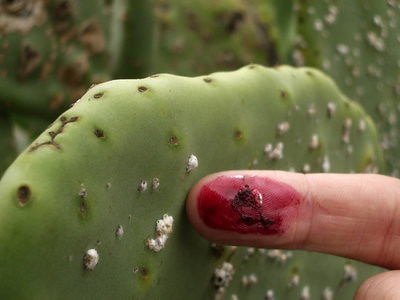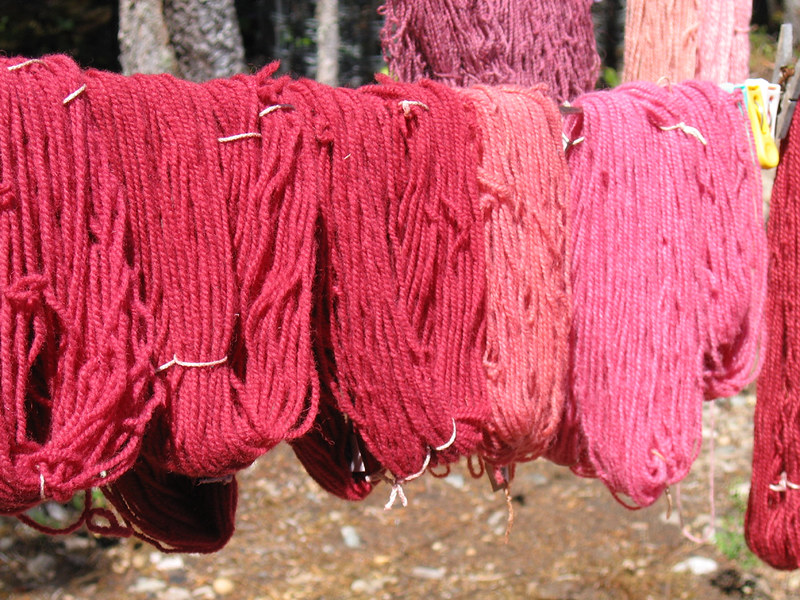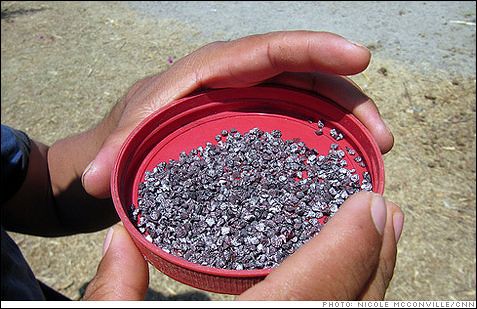At the liquor store the other day I noticed a bottle of shocking pink tequila, called ?Pasi?n.? It would make a great Valentine?s Day gift (?Candy?s dandy, but liquor?s quicker,? as my father used to say) and is certainly eye-catching. More interesting, I learned that the pink color came from cochineal bugs ? as stated right up front on the label!
Most people don?t know about cochineal bugs or the widespread use of colorant that?s extracted from them, but cochineal, or carmine, has been valued for centuries as a red dye. One of the few natural and water-soluble dyes that resists degradation with time, cochineal is the most light-stable, heat-stable and oxidation-resistant of all the natural colorants and is even more stable than some synthetic dyes. Moreover, depending on the process used, it yields a range of vibrant colors, from light oranges and pinks to deep crimson.

Cochineal, close up
Unfortunately, when you inform people that their raspberry yogurt, maraschino cherries, Starbucks Strawberry Frappuccino, brand of lipstick, or hundreds of other items are colored with this natural extract, most are revolted instead of intrigued. In fact, outraged vegans have pressured Starbucks to look for another, non-insect-derived product to use in the frappuccino concoction (just do a web search for ?cochineal and Starbucks?).
So what IS a cochineal bug, exactly?? It is a small, chubby scale insect that feeds on prickly pear cactus, with the scientific name of Dasylopius coccus. There are many species of scale insect. Most are very small (i.e., less than ? inch long, some smaller), sedentary insects that suck plant sap with tiny, piercing mouth parts. They belong to the same order of insect that includes aphids, cicadas, and leaf hoppers: the Homoptera.
However, you might not even recognize some scale species as insects. Adult females have no legs or wings and are basically bags of guts and eggs that seem glued to the stems or leaves of their host plant (the smaller, winged males are seldom seen). Some scales have hard, shell-like coverings, and indeed look like tiny shells. Mostly considered plant pests, a few have economic value. For example, shellac is another natural product derived from a different scale insect.

Cochineal as they appear feeding on prickly pear cactus
Cochineal bugs are covered with a waxy or powdery white coating, and often cluster on the surface of the prickly pear pads, looking like tiny cotton balls stuck to the plant. But if you squish these cottony balls, your fingers will be covered with copious amounts of a thick, dark red fluid. This intense color has been used to dye fabric for many centuries, and more recently, has become an important colorant in foods and drinks.
Cochineal bugs are native to Central and South America, where their host plants, the cacti, also originated. Both Incas and Aztecs used cochineal as a dye, which was so highly prized that bags of the dried bugs were used as currency or as tribute. The Spaniards took cochineal back to Spain, and during colonial times, cochineal was Mexico?s second-most valuable export after silver. Cochineal was much superior to the red dye used in Europe at that time, and became hugely popular. It was used to dye the cloaks of Roman Catholic cardinals and the ?redcoats? used by the British army.

Cochineal-dyed yarn
In the mid 1800s, with the advent of chemical dyes, which were cheaper to produce, the demand for cochineal in the fabric industry waned and the industry all but collapsed. But in the late 1900s, the push to use natural products rather than chemical ones in foods have made cochineal and carmine, its purified form, increasingly important as food colorants.? Today cochineal is again produced on a commercial scale.
To quickly summarize the production process: cochineal bugs are allowed to grow on prickly pear pads for about three months. They are then scraped off the pads and thoroughly dried (often sun-dried) for several days. The resulting seed-like pellets are ground and mixed with water to produce cochineal, or are further refined to produce carmine or carminic acid. It takes about 70,000 bugs to make one pound of cochineal extract.

Dried, harvested cochineal
Today most cochineal comes from Peru, the Canary Islands, and Mexico. Check out this YouTube video to see traditional cochineal farming in the Canary Islands. You might also be interested in this great video from the North Carolina Museum of Natural Science about cochineal in foods.
If you?d like to learn more, just do an online search for ?cochineal bugs? (by the way, they have occasionally been misnamed ?cochineal beetles? ? but they are NOT beetles). For those of you who prefer old-fashioned reading, Amy Greenfield has written an entire book about the fascinating history of cochineal titled A Perfect Red.

Cochineal harvesting in colonial Peru
I personally have little tolerance for people who act horrified when they learn that the red color of their Gatorade, popsicles, or other foods comes from or is enhanced by these insects. And vegans ? please!? We eat insects all the time. There are government-approved amounts of insects allowed in almost all foodstuffs (also other, ickier stuff such as rat feces, animal hair, and dirt). That chocolate bar, slice of bread, bowl of cornflakes, serving of pasta, dollop of ketchup ? all are likely to have bits of insects in them.
I encourage you to visit the exhibit on this theme in our entomology hall, where you can also purchase some unadulterated insect treats from our vending machine. Did you know that the average American eats ? unknowingly ? one to two pounds of insects per year? But not to worry, insects contain lots of protein and are good for you!
A very few people ? vastly fewer than have peanut or wheat allergies ? may have an allergic reaction to cochineal extract (one source says the allergy is due to impurities introduced in the production process rather than to the carminic acid). These people should certainly read labels and avoid products that contain cochineal or carmine.? The coloring ingredient may be identified on labels as cochineal extract, carmine, crimson lake, natural red 4, C.I. 75470, E120, or even ?natural coloring.?
Other people do not want to eat cochineal because of ethical or religious concerns (they are not considered kosher). However, if you are truly concerned about eating or using products containing cochineal, you will have to read the fine print on a lot of products.? Here is a short list of items that may contain cochineal-derived colorant:
- Frozen meat and fish (e.g., artificial crab meat)
- Soft drinks, fruit drinks, energy drinks, and powdered drink mixes
- Yogurts, ice cream and dairy-based drinks
- Candy, syrups, popsicles, fillings and chewing gum
- Canned fruits including cherries and jams
- Dehydrated and canned soups
- Ketchup
- Some wines and liqueurs (sadly, according to Wikipedia, as of 2006 carmine is no longer used to give the Italian aperitif Campari its distinctive deep red color)
- Lipstick, eyeshadow, blush, nail polish, and other cosmetic items
- Pills, ointments and syrups used in the pharmaceutical industry
Personally, not suffering from a rare allergy or having any ideological qualms, I would far rather ingest a time-honored, natural dye than artificial food colorings made from coal tar, many of which have been proved to be carcinogenic and/or cause behavioral problems (for which reasons an increasing number have been banned from use in foods).
A final note: Interestingly, the cactus family is a member of the plant order Caryophyllales, which includes the beet family, the pokeweeds, bougainvilleas, succulents (Crassulaceae), and a few others. These are the only plants that contain red plant pigments called betalains (red pigments found in most other plants are anthocyanins).? Betalains are known to be powerful antioxidants with anti-cancer and anti-inflammatory properties (so eat your beets!). The carmine color of cochineal bugs is very similar to the red found in beets (and in some cactus fruits). I suspect ? but can find no confirmation ? that carmine in cochineal bugs is derived from this plant pigment.

Cheers to that!
I have never seen cochineal insects in Houston, but have found them on prickly pears growing in and around Austin ? so they certainly occur in Texas. If you know where some prickly pears are growing, check them out!
Source: http://blog.hmns.org/2012/11/color-me-carmine-cochineal-bugs-in-our-food-and-drink/
wwe wrestlemania oakland shooting mega millions winning numbers autism speaks ubaldo jimenez ncaa final country music awards
No comments:
Post a Comment
Note: Only a member of this blog may post a comment.